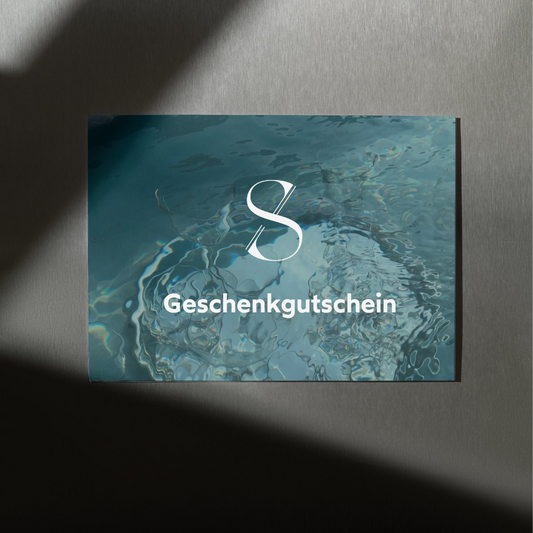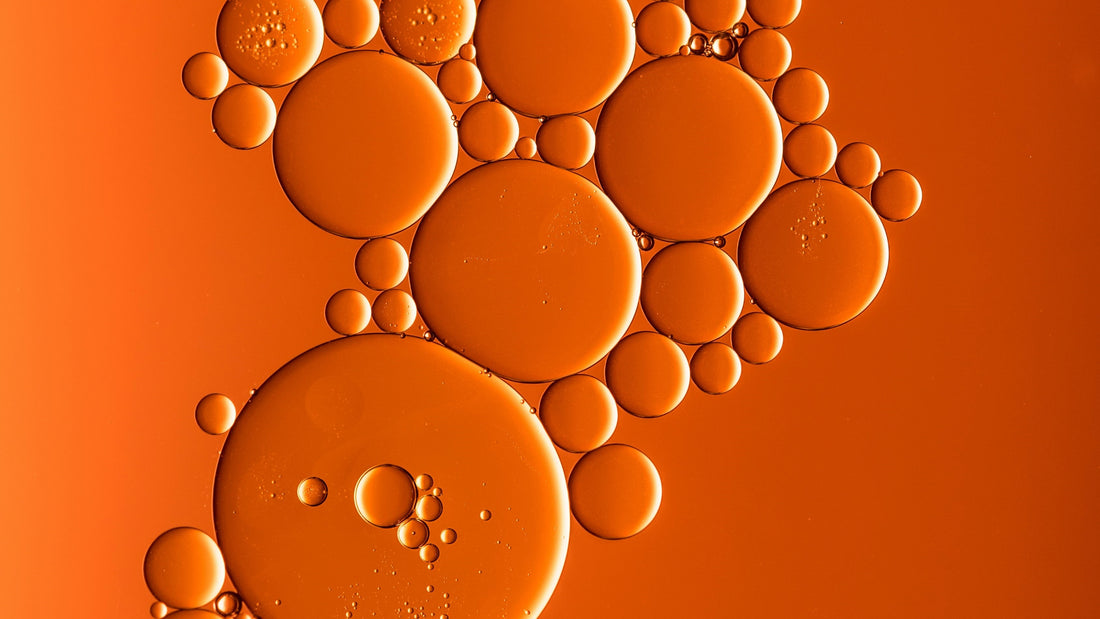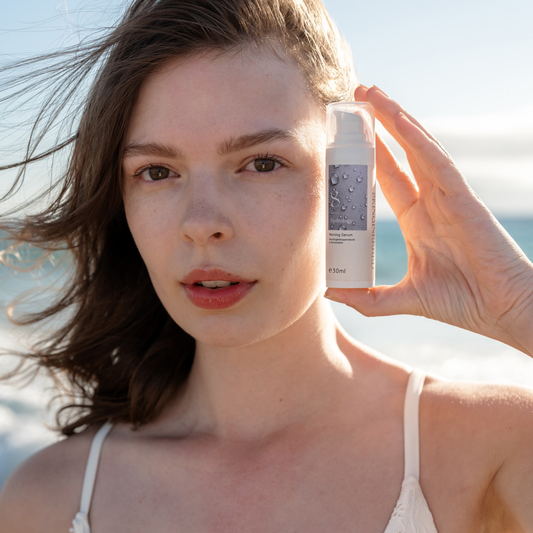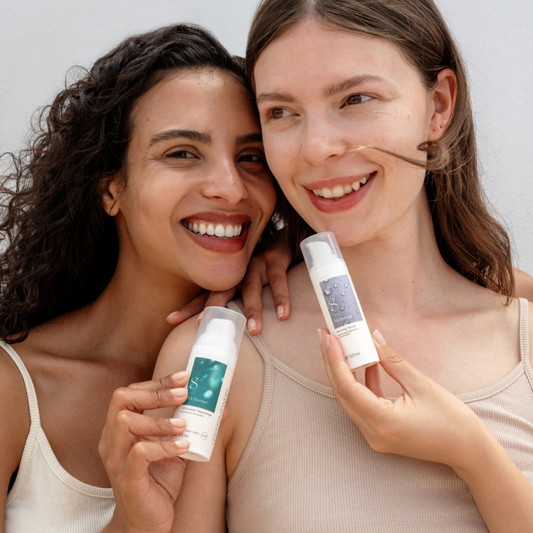This article provides a comprehensive overview of almost all UV filters approved in the EU. We explain their properties, advantages, and disadvantages so you can find the best sunscreen filters for your needs.
Important note: Every approved UV filter offers protection against UV radiation (the protection factor is tested on volunteers, regardless of the formulation). I've marked my personal favorites with a 💜. None of the listed UV filters have been proven to be harmful to health. Some cause intolerances slightly more often than others, but these are rare and individual. Some outdated filters, such as benzophenone or oxybenzone, are virtually no longer used in the EU and are therefore not included in this list.
Contents
- Inorganic filters
- Organic filters
- UVB filter
- UVA filter
- Broadband filter
- Mexoryl filter (L'Oréal patents)
Inorganic filters
Inorganic UV filters (also known as physical or mineral filters ) offer effective sun protection, but often have the disadvantage of leaving the skin looking white (so-called white cast ). Nanoparticles of these filters produce a less pronounced white cast. These filters are the only ones permitted for use in certified natural cosmetics. To date, no allergies to mineral filters have been reported, making them a good choice for people with very sensitive skin or eyes.
Titanium Dioxide (nano)
Other designations : CI77891, TiO2
Titanium dioxide is a broad-spectrum filter. It is most effective in the UVB range. As a food additive, titanium dioxide was recently banned in the EU due to inconclusive research. It can be assumed that titanium dioxide is safe in cosmetics, provided it is not inhaled as an aerosol (from sprays or powders).
Nerd fact: Titanium dioxide is used particularly in decorative cosmetics to make colors more opaque or as a glitter pigment. It is also used in wall paint as a white pigment.
Zinc Oxide (nano)
Other names : Z-Cote®, ZnO
Zinc oxide is a weak broad-spectrum filter and must be used in relatively high concentrations. It offers stronger UVA protection than titanium dioxide. Additionally, zinc oxide has anti-inflammatory and even slightly mattifying properties, making it particularly beneficial for blemished, oily skin .
Caution: Modern zinc oxide filters are usually coated to prevent the particles from clumping together and reacting with other substances. Some natural cosmetic products may still contain uncoated filters. In these cases, caution is advised when combining them with other products.
Furthermore: DIY with zinc oxide is not a good idea at all! First, there's the issue with the coating. Second, it can only be dispersed finely enough with industrial mixers with a high shear rate. Third, there's no reliable SPF ( sun protection factor ) without official testing.
Organic filters
Organic filters contain carbon in their structure. This group allows for a wide variety of different types. The term "organic" historically stems from the association of these molecules with the "chemistry of life." They are also referred to as synthetic or chemical UV filters (although, of course, inorganic filters are also chemically based and industrially manufactured).
Organic filters come in various forms: they can be a liquid oil in their pure form or a powder (oil- or water-soluble). There are also insoluble organic filters, which exist as fine particles and thus have similar properties to inorganic filters. These are also called hybrid filters .
Among UVB filters, there are significantly more "old-fashioned" filters . Previously, the importance of UVA protection wasn't as well recognized. However, this aspect was taken into account in the development of the new generation of filters.
Organic UVB filters
Diethylhexyl Butamido Triazone 💜
Other names: Uvasorb® HEB, Iscotrizinol, DBT
Effective, modern UV filter. Powder dissolves very well in oils. No allergic reactions observed to date.
Ethylhexyl Methoxycinnamate
Other names: Octinoxate, EHMC
It needs to be stabilized by other filters. A rather old-fashioned filter. Still very commonly used in products from the USA.
Ethylhexyl Salicylate
Other names: Octisalate, EHS
It is not photostable on its own, but in combination with other UV filters it is an established and widely used filter. In its pure form, this filter is a liquid oil.
Ethylhexyl Triazone 💜
Other names: Uvinul® T150, Octyltriazone, EHT
Modern UV filter. Highest absorption coefficient among photostable filters. No allergic reactions observed to date.
Homosalate
Still approved at 7%. Very good solvent for other UV filters. Burning eyes are frequently attributed to this filter.
Octocrylene
Formerly the most commonly used filter. Stabilizes other UV filters. Does not offer high protection itself, but dissolves other filters very well and creates elegant textures.
Unfortunately, due to low concentrations of degradation products after the expiration date, sunscreens have gotten a somewhat bad reputation. However, those who open a fresh tube of sunscreen every year and store it properly have nothing to worry about in this regard.
Phenylbenzimidazole Sulfonic Acid
Other names: Ensulizole, PBSA
Very stable and even anti-inflammatory. This filter itself has a rather low absorption profile, but is often used in small concentrations as a supplement to other UV filters. One of only two water-soluble filters that are not patent-free.
Polysilicone-15
Other names: Parsol® SLX, Dimethico-Diethylbenzal-Malonate
Lightweight, stable silicone-based filter. Promotes a pleasant skin feel.
Organic UVA filters
Unfortunately, the list of currently available pure UVA filters is not very long. However, broadband filters can also be used for additional UVA protection.
Butyl Methoxydibenzoylmethane 💜
Other names: Avobenzone, BMDBM
Highly effective UVA spectrum. Not photostable on its own, but achieves recovery rates of over 80% in combination with other filters such as octocrylene or Tinosorb® S. Currently the only UVA filter approved in the USA.
Included in the Skinengineered UVA Booster .
Diethylamino Hydroxybenzoyl Hexyl Benzoate 💜
Other names: Uvinul® A Plus, DHHB
Modern, stable UVA filter with high skin compatibility. Even has antioxidant properties.
Included in the Skinengineered UVA Booster .
Disodium Phenyl Dibenzimidazole Tetrasulfonate 💜
Other names: Neo Heliopan® AP, DPDT
A stable UVA filter that is even water-soluble . This allows for a more watery and lighter skin feel.
Included in the Skinengineered UVA Booster .
Organic broadband filters
Bis-Ethylhexyloxyphenol Methoxyphenyl Triazine 💜
Other names: Tinosorb® S (Lite Aqua), BEMT
Modern, broad-spectrum protection of the new generation . Can stabilize avobenzone. Very skin-friendly and even has a slight anti-inflammatory effect. Also has an antioxidant effect. A water-soluble version encapsulated in a polymer is also available (recognizable by the ingredient Acrylates/C12-22 Alkyl Methacrylate Copolymer).
Included in the Skinengineered UVA Booster .
Methylene Bis-Benzotriazolyl Tetramethylbutylphenol (nano) 💜
Other names: Tinosorb® M, MBBT
Stable hybrid filter . Due to its particulate properties, it may leave a slight white cast, similar to mineral filters. Very low risk of allergies and skin irritation. Very broad absorption spectrum extending into the blue visible light range.
Phenylene Bis-Diphenyltriazines 💜
Other names: TriAsorB™
Available since 2019 and found exclusively in Pierre Fabre products, such as those from the Avène brand. It has a very broad absorption spectrum extending into the blue visible light range. Therefore, it may leave a slight yellow cast on some lenses.
Tris Biphenyl Triazine (nano) 💜
Other names: Tinosorb® A2B, TBPT
Due to its particulate properties, it may leave a slight white residue, similar to mineral filters. It is similar to Tinosorb S & M.
L'Oréal Patents
These filters are all broadband filters and, due to patents, are exclusively found in L'Oréal products (brands such as Garnier, La Roche Posay, Vichy, Skinceuticals, Biotherm, etc.).
Drometrizole Trisiloxane 💜
Trade name: Mexoryl® XL, DTS
Stable, waterproof filter. Pioneer patent from 1982. Works synergistically with Mexoryl SX.
Methoxypropylamino Cyclohexenylidene Ethoxyethylcyanoacetate 💜
Trade name: Mexoryl® 400, MCE
Approved since 2020, making it the newest filter on the market. It offers the most effective protection in the long-wave UVA range. Found, for example, in La Roche-Posay UVMune400 products.
Terephthalidene Dicamphor Sulfonic Acid 💜
Trade name: Mexoryl® SX, TDSA
Strong UVA protection. Water-soluble. Proven to barely penetrate the skin.
In conclusion...
...perhaps another question: why do so many sunscreens leave a greasy feeling ?
To slow down UV radiation, filters must contain "elastic" electrons. This is provided by the hexagonal, honeycomb-shaped structures in molecules. They even look a bit like trampolines :) These so-called benzene rings are only slightly soluble in water. Most filters are therefore oil-soluble and require a similar amount of additional solvents with oily properties to distribute them properly in the cream.

If a cream consists of 25% filters, it will be composed of approximately 50% oily ingredients. This is a significantly higher proportion than in moisturizing creams.
Your Ying
Engineer, cosmetic scientist and founder of Skingineered













8 comments
Danke für diese tolle Aufstellung! Ich hab ein Produkt von Beauty of Joseon gefunden, bei dem auch zwei L’Oreal Filter drin sind. Vielleicht wollt ihr den einleitenden Abschnitt zu L’Oreal anpassen. Produkt: Beauty of Joseon Relief Sun Aqua-fresh : Rice + B5 SPF50+. Filter: Mexoryl XL, Mexoryl SX.
Soo coole Aufschlüsselung der UV-Filter! Danke für deine Arbeit :)
Total interessant! Und wirklich klasse, diese Informationen alle gebündelt zu haben, und dass man direkt die Namen nachgucken bzw vergleichen kann. Die verschiedenen Bezeichnungen sind schon sehr verwirrend 😅 Danke dass du dir immer so viel Mühe für uns gibst!
So eine gute, knackige Zusammenfassung 👌🏼😊
So viele Infos. 😍
Vielen Dank